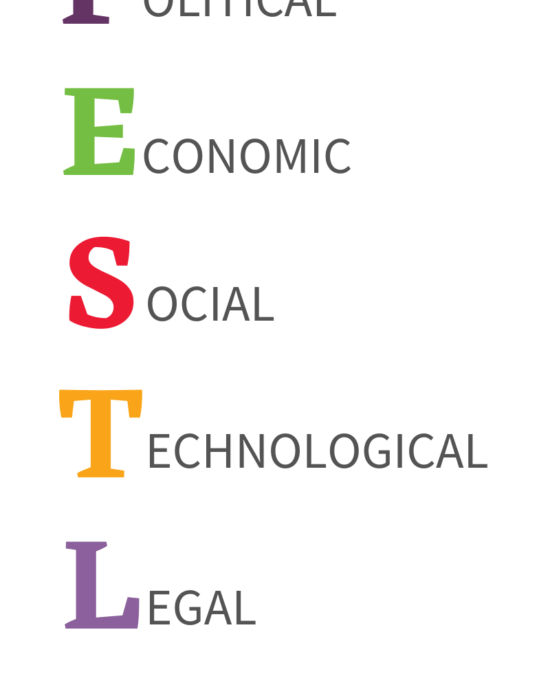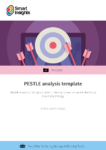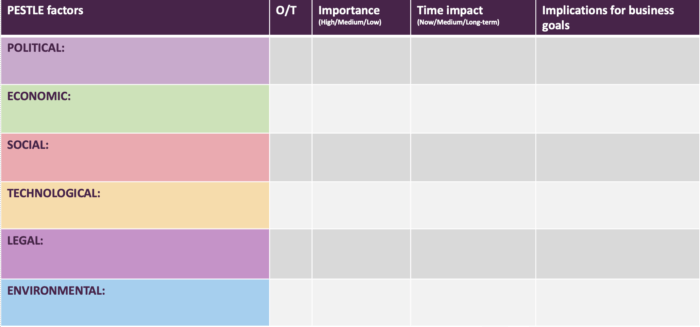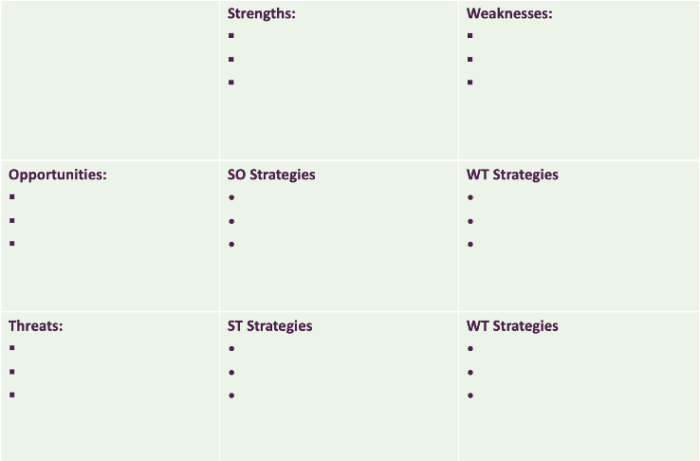Learn how to create a PESTLE analysis to identify threats and opportunities in the macro environment to guide your marketing planning
You may have heard PESTLE mentioned when studying marketing theory or in your workplace. It is a powerful, yet simple, analysis tool for overall business and marketing planning. In this blog we explain what it is, why it is useful, and how you can create your own PESTLE analysis for marketing planning today.
What is a PESTLE analysis?
PESTLE is an acronym that covers 6 key areas in your macro (external) environment. Each letter stands for a different factor, as shown in the graphic below:
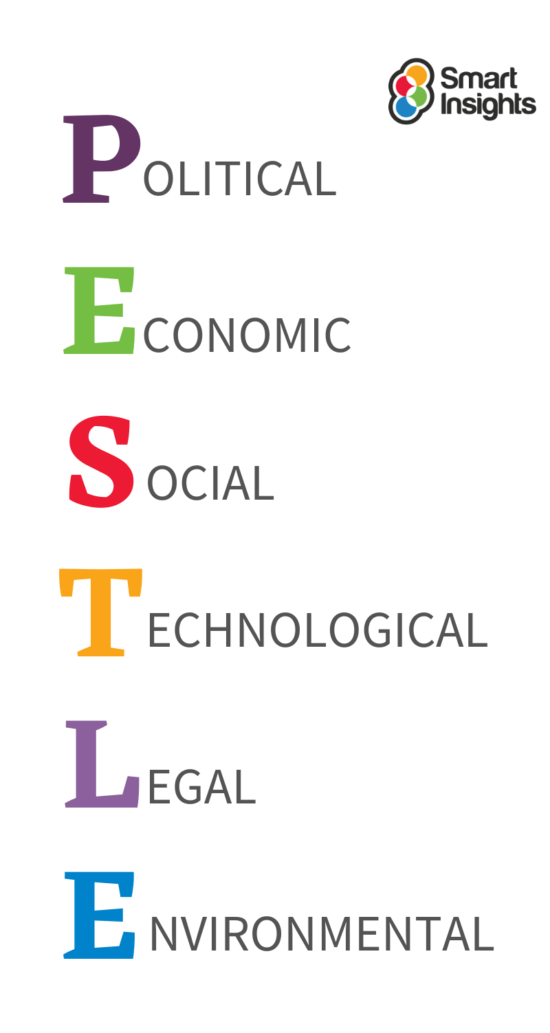
Did you know? Sometimes it is referred to as a PEST analysis, or spelt ‘PESTEL’, but the most common acronym is PESTLE.
A PESTLE analysis is a framework to help you identify external factors – happening outside of your control – that can affect and influence your business objectives and marketing strategy.
Is it necessary to look at external factors when marketing planning?
You may initially think that perhaps a PESTLE analysis for marketing planning is going overboard. You have a good marketing plan in place for your business which you are in control of. What is the point of looking at external factors if you cannot change them?
As busy marketers, it is understandable that often we spend more time focussing on our internal environment. But the reality is, without assessing your external environment, you are missing out on identifying opportunities and threats facing your business, whether you acknowledge them or not.
Consider the popular myth about ostriches. They were once thought to stick their head in the sand to hide from predators. To them, they felt nice and safe in their dark hole, when really the rest of their body was very much on show and vulnerable to danger. Not assessing your macro environment is a business’ way of sticking its head in the sand and hoping for the best. It is also a really good way of getting overtaken by your competitors (fellow prey), who are always scanning for potential danger. Not ideal.
Why use a PESTLE analysis for marketing planning?
When creating a marketing strategy, you need to assess internal (micro) and external (macro) factors to find opportunities and threats for your plan to tackle. A PESTLE analysis for marketing planning is a great, quick way to see a top-level view of your macro environment. What is going on outside of your internal environment, that you have little/no control over, that will have an impact on your business? It’s a chance to react to external influences and create tactics to tackle any challenges/opportunities.
Top Tip: PESTLE is part of situation analysis which is part of the opportunity part of RACE OSA Planning.
It is common for businesses to focus on the more immediate micro environment factors like customers, competitors and intermediaries to reach and trade with them. While this is important, PESTLE is useful for revealing broader changes in the market which may give opportunities that impact on the micro environment factors and helps review legal factors.
Examples of opportunities and challenges that PESTLE can reveal include:
- Societal and cultural changes which impact the go to market strategy
- New marketing technology and related communications techniques
- Government changes which may give new sources of funding, e.g., R&D, digital apprenticeships
- Legal changes that will need to be adhered to (for example, privacy law)
“Why is PESTLE analysis important? Because these factors can influence your business strategy and impact future decisions such as expansion, recruitment, and product development.” (SimplyBusiness).
How do I create a PESTLE analysis for marketing planning?
To create your PESTLE analysis, you need to research your macro environment. You are looking for Political, Economic, Social, Technological, Legal and Environmental events/changes that will impact your business and future goals. Have a look at respectable news and industry forums and websites to start.
Then you need to assess what that impact is. Is it High/Medium/Low? What sort of time-scale is the impact? Is it an Opportunity or Threat for your business? Or both?
Top Tip: Not all 6 PESTLE elements may be relevant for your business; focus on areas that have a definite impact.
Presenting your PESTLE analysis
The easiest way to present your PESTLE analysis is in a table format. Smart Insights have created an easy-to-use PESTLE template to help you create and display your analysis.
The table splits out the key information you need to assess for each PESTLE factor.
- O/T – This stands for Opportunity or Threat – is the impact on your business positive or negative?
- Importance – Is it high, medium or low for your business? This is a good column for prioritizing action.
- Time impact – When will this affect your business?
- Implications for business goals – Most useful column to complete. This is where you bring all the information together to create actionable insight. What is the main implication of this external factor on your business specifically? How can you respond to it?
Top Tip: When assessing Opportunities and Threat factors, consider whether they could be both. For some areas, Threats will create Opportunities which your business can use to its advantage to mitigate the initial threat.
B2C PESTLE example
In our PESTLE analysis template we created a completed example for a fictitious B2C company to help you conduct your own analysis.
Let’s take a look at an example of a factor that could be an opportunity and a threat.
Here, our customers are becoming aware of the impact of their consumerism on the environment. If we do nothing about this, our company will lose business as we are not adapting to our customers’ needs. However, we now know what our customers want. This creates an opportunity for us to meet that need, to retain and gain more customers by improving our business’ environmental impact and using that as a point of difference in marketing comms.
Download our PESTLE analysis template to see a complete example across all external factors.
How often do I need to conduct a PESTLE analysis?
As marketers, we know that our digital environment changes constantly. It is why we are masters of optimization! The same can be said for our external environment. Changes to our macro environment happen often and swiftly, so it is recommended to conduct a PESTLE analysis regularly. Oxford College of Marketing suggests conducting a PESTLE analysis every six months:
“This analysis should be repeated every six months to identify any changes in the macro-environment. Organisations that successfully monitor and respond to changes in the macro-environment can differentiate from the competition and thus have a competitive advantage over others.” (Oxford College of Marketing).
If this is too unrealistic for your business, we recommend creating a new PESTLE analysis every 12 months.
Turning your PESTLE analysis into action
Your PESTLE analysis is a great basis for identifying potential threats and opportunities that you can use in a SWOT/TOWS analysis. The TOWs matrix brings together strategic opportunities and threats to tackle in your strategy.
We have a dedicated template to help you conduct your SWOT analysis. It also goes through how you can use RACE to prioritize your key issues and create actions.
We hope you’ve found this blog helpful. Download our PESTLE analysis template for more tips on how to make the most of your analysis, and to see a completed worked example.

